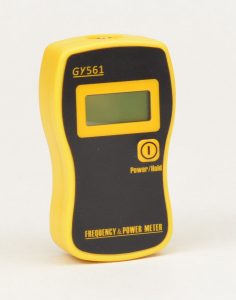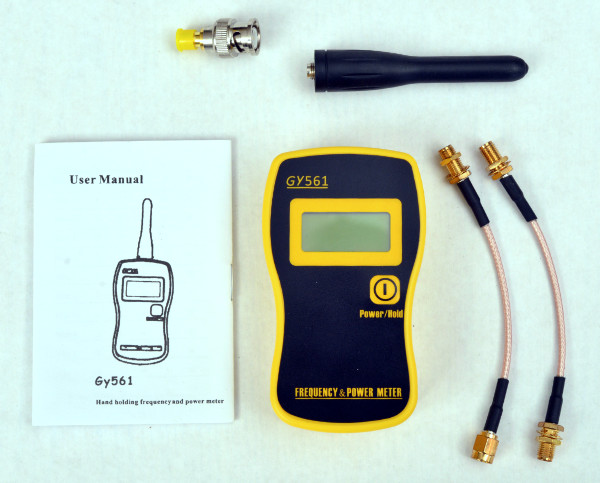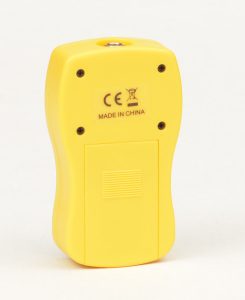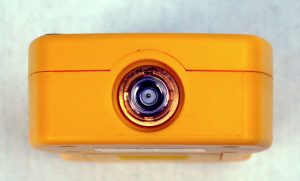The GY561 is a small and inexpensive power meter and frequency counter that should make it easy for you to test your radios. Small enough to fit into your pocket with plenty of room left over, it includes the cables needed to attach it to most handheld radios as well as a small antenna for the frequency counter function. Coming in at $40, it seems hard to beat that much functionality at that price point.

The accessories that come with the GY561 are remarkably good, considering the price. While short, the cables seem well put together and of decent enough quality. The instruction manual is fairly typical of a cheap piece of Chinese technology but serviceable considering the ease of use of the meter. It runs off of three AAA batteries which is easy enough to find around my house.

Hooking the GY561 up and getting readings is straightforward. You turn the meter on, connect the cables, and press the PTT button on your radio. The screen shows you the power output and the readings are fairly stable. Holding the PTT down for a while, of course, does tend to make the power level change as the electronics in the GY561 get saturated with the load. I find you should hold the PTT down for about three seconds and always take the reading at that time. This provides the best consistency.
Speaking of consistency, this little GY561 does tend to provide fairly repeatable results. This means that if you run a test on a radio today, and then again tomorrow, the results will be close enough to be considered the same. This was one of my big concerns as I wanted to use the GY561 to compare radios so I needed it to be consistent more than accurate.
The next thing I tested was the frequency counter portion of the GY561 and it seemed to be very accurate. I would say the bulk of the time the GY561 was accurate to within a couple of hundredths of a megahertz, not bad for this price. I was also pleased that it read from a reasonable distance as some meters I have dealt with have to be pretty much touching the antenna of the radio in order to work. This one seems to work from a few inches away which I liked.
This is where the good news about the GY561 stops.

The power readings from the GY561 are off, sometimes way off. There seems to be no rhyme or reason. If you have a radio that is supposed to put out 5w, the GY561 may show 3.1w. Ok, that could be right, right? Sure. But then you put a radio on the GY561 that is supposed to put out 8w and it shows 2.9w. OK, strange, but also possible. Put another 8w radio on the GY561 and you get 6w. Fine, that is also possible. But here is where things get interesting.
Put those same three radios on a nice, and substantially more expensive power meter, and the readings go from 3.1, 2.9, and 6 with the GY561 to 4.5, 6.9, and 7.1 with the new power meter. This happens over and over again.
What I have determined about the GY561 is that however it determines the power output from the radio is complete garbage. Higher power output sometimes shows as higher, sometimes as the same, and sometimes as lower, you just never know. This right here makes it completely useless for my purposes of comparing radios. In fact, I can’t think of any use for the GY561 as a power meter.

I went looking online to see if I was the only one with a problem with their GY561 and I was not. There seemed to be two groups of people using the meter: those who had a radio or two and have no idea how bad the meter is, and those who hate the GY561. Given the number of people talking about it, at least it seems the marketing department for this little meter does a fine job 😉
In all fairness, there is a calibration procedure you can follow to get the GY561 more accurate, and it does work, kinda. After three attempts at calibrating it, I could get it to be reasonably close to my big meter but it seems to still be confused by some radios. What I mean is that sometimes hooking up a new radio that I know has a certain amount of power output, shows something wildly different with this meter. You just can’t trust it. The radios I used to calibrate the meter all seem to read as they should later on so I will assume the calibration holds.
My biggest problem with this is that it felt like when I used radio XXX to calibrate it at 145MHz and 5w, that held, and if I hooked the same radio up later, it showed 145MHz at 5w but did not really do anything for a different radio at 145MHz and 5w, it could still read wildly off. So what does that mean? To me, it means I had to tell the GY561 what it should say instead of it telling me what was actually going on.
I suppose if you want to just use the GY561 as a frequency counter you certainly could, however, there are much better frequency counters out there with more features such as the SURECOM SF401. Yes, the SF401 is a little more expensive than the GY561, but it is rechargeable so I don’t need batteries. has a better antenna, a much nicer screen, and displays tone frequencies which the GY561 does not.
For a power meter, I hate to say it, but save your pennies and buy the Diamond SX400 for VHF/UHF or the Diamond SX1100 if you need to cover more frequencies. These tend to be substantially more accurate, will take more power, and although I sold my GY561, I would bet the Diamond’s will last a lot longer. You will need to buy your own adapter cables with these as well.

